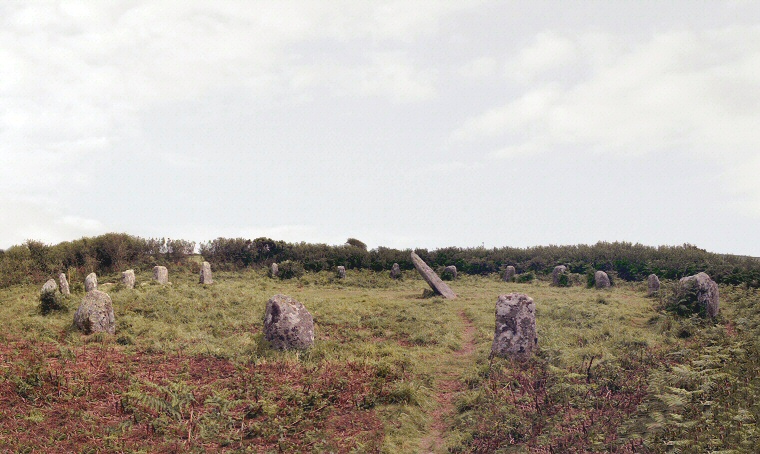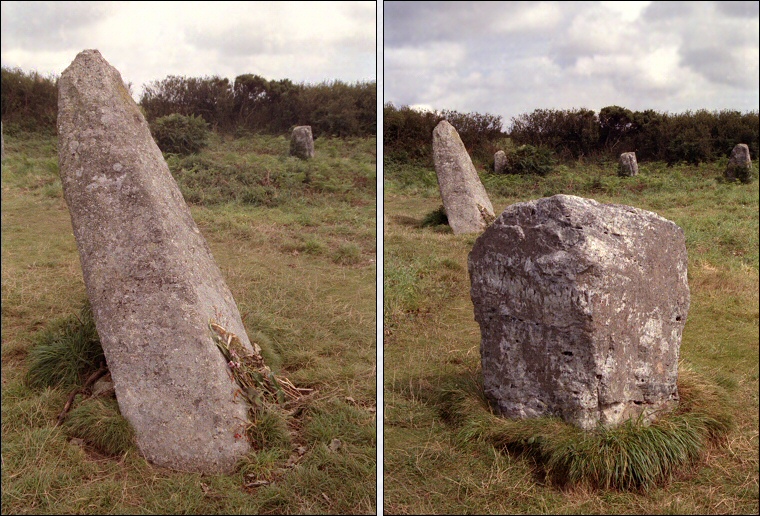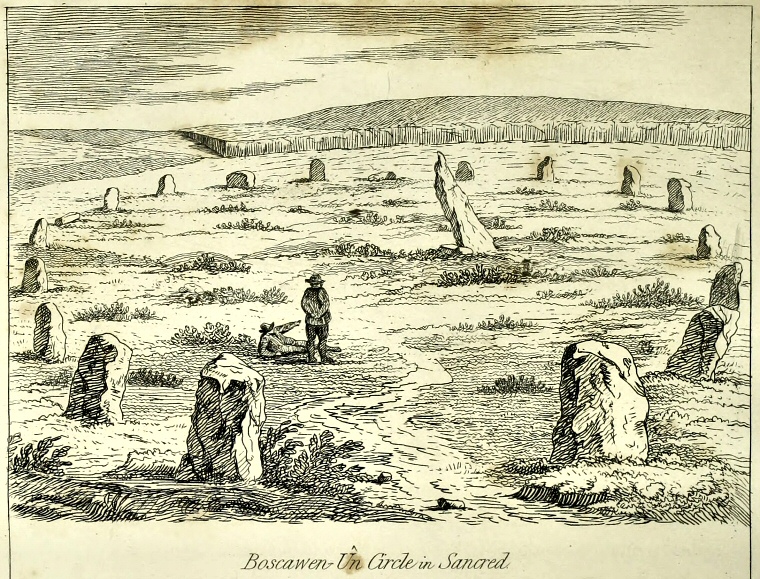
Boscawen-Un is an almost impossibly beautiful and secluded stone
circle set on a gently southwest facing slope that leads down 200 metres to a small un-named stream that eventually meanders to the sea at Lamorna Cove 5km (3 miles) to the southeast.
The ring of nineteen granite blocks is in fact slightly oval being about 25 metres northwest-southeast by 22 metres northeast-southwest with the stones being fairly regularly spaced except for a gap towards the west which may have been the location of a further missing stone but may equally have formed an entrance to the circle. The stones themselves are not particularly large, standing between a metre and 1.4 metres tall and are roughly dressed on their outer faces but have smoother sides facing into the circle. One particular circle stone however stands out as being different, when the second stone to the south of the entrance is examined more closely it reveals itself to be beautifully rich in quartz (image below right) with the assumption being that this stone was specially chosen by the circle builders and possibly placed in a position within the ring (the west-southwest) that held significance to them. On the northeastern edge of the circle a pair of prostrate slabs were suggested by the 18th century antiquarian William Borlase to be the broken remains of a burial cist.
Probably the most immediately noticeable element of the site however is the dramatically north-eastwards leaning stone located to the southwest of the centre of the circle, a finely shaped granite pillar about 2.5 metres in length. Often stones lean either because they were placed in sockets that were too shallow, attempts have been made to topple them or due to subsidence caused by people digging at their base in the search for the buried treasure they think the stone marks. However at Boscawen-Un excavation around the base of the stone in the 1860's resulted in the claim that the pillar had been deliberately placed at its present angle but without the benefits of modern archaeological techniques we can't take this as definitive proof that this was the builders intention.
What we also don't know is when the stone arrived here, was it an existing standing stone that the circle was built around, is it contemporary with the circle or was it added later and if so how much later. Stone circle expert Aubrey Burl speculates it could have stood here before the circle as this whole area near the tip of Cornwall is heavily populated with standing stones that may have had sacred meaning in prehistory and often have stone circles located near by, however he also describes this pillar as 'controversial' but sadly doesn't elaborate further. One thing that is certain however is the antiquity of the stone itself. As recently as the mid 1980's rock-art in the form of a pair of axes carved in relief were found towards the base of the inner face of the pillar, although more recently author Tom Goskar has interpreted these carvings as feet (see photographs on Tom's website here) and goes on to speculate that a pair of circular carved features may represent breasts. As this type of carving is often associated with passage graves of between 3000-2500BC Tom suggests that the pillar may have come from a destroyed or dismantled Neolithic tomb nearby. If the pillar pre-dates the circle as Burl believes then this would probably date the circle to the late Neolithic or early Bronze Age.
In my original notes for the site I wrote:
'Boscawen-Un rewards the persistent circle seeker who manages to find this, my favourite of the Cornish stone circles. After finding a suitable place to park the car, the visitor has to wade chest deep through bracken and gorse and ever present airborne stinging beasties down the hillside to the clearing that is the home to this fine fairy ring of nineteen granite blocks and its titled off-centre spire, looking like some kind of prehistoric sundial. During Medieval times this circle was recorded as being one of the three major Druidic meeting places of Britain and was the site of the inauguration of the Gorsedd of the Bards of Cornwall in 1928.'
I believe the paths to the site are now regularly cleared and access to the circle is much easier. A shame in some ways as part of the attraction of Boscawen-Un was its tranquility, in part as a result of its inaccessibility, compared to the nearby popular Merry Maidens 3.4 km (2 Miles) to the southeast, a circle to which Boscawen-Un shares a great deal of similarity.
The name Boscawen-Un is the Anglicised version of the Cornish Boscawen-Żn, said to mean 'the dwelling by the elder tree on the down' (bos - a dwelling, seawen - an elder tree, oon - down, according to Grinsell), while the nearby hamlet half a mile to the east is spelled as Boscawenoon - both may be descended from the earlier names of Beisgowan and Biscawoon. An alternative name for the circle is the 'Nine Maidens', a name it shares with several other stones circles across Britain, such as the nearby circle at Boskednan 5 miles (8km) to the north-northeast, that is often completely unrelated to the actual number of stones the circles contain.
The ring of nineteen granite blocks is in fact slightly oval being about 25 metres northwest-southeast by 22 metres northeast-southwest with the stones being fairly regularly spaced except for a gap towards the west which may have been the location of a further missing stone but may equally have formed an entrance to the circle. The stones themselves are not particularly large, standing between a metre and 1.4 metres tall and are roughly dressed on their outer faces but have smoother sides facing into the circle. One particular circle stone however stands out as being different, when the second stone to the south of the entrance is examined more closely it reveals itself to be beautifully rich in quartz (image below right) with the assumption being that this stone was specially chosen by the circle builders and possibly placed in a position within the ring (the west-southwest) that held significance to them. On the northeastern edge of the circle a pair of prostrate slabs were suggested by the 18th century antiquarian William Borlase to be the broken remains of a burial cist.
Probably the most immediately noticeable element of the site however is the dramatically north-eastwards leaning stone located to the southwest of the centre of the circle, a finely shaped granite pillar about 2.5 metres in length. Often stones lean either because they were placed in sockets that were too shallow, attempts have been made to topple them or due to subsidence caused by people digging at their base in the search for the buried treasure they think the stone marks. However at Boscawen-Un excavation around the base of the stone in the 1860's resulted in the claim that the pillar had been deliberately placed at its present angle but without the benefits of modern archaeological techniques we can't take this as definitive proof that this was the builders intention.
What we also don't know is when the stone arrived here, was it an existing standing stone that the circle was built around, is it contemporary with the circle or was it added later and if so how much later. Stone circle expert Aubrey Burl speculates it could have stood here before the circle as this whole area near the tip of Cornwall is heavily populated with standing stones that may have had sacred meaning in prehistory and often have stone circles located near by, however he also describes this pillar as 'controversial' but sadly doesn't elaborate further. One thing that is certain however is the antiquity of the stone itself. As recently as the mid 1980's rock-art in the form of a pair of axes carved in relief were found towards the base of the inner face of the pillar, although more recently author Tom Goskar has interpreted these carvings as feet (see photographs on Tom's website here) and goes on to speculate that a pair of circular carved features may represent breasts. As this type of carving is often associated with passage graves of between 3000-2500BC Tom suggests that the pillar may have come from a destroyed or dismantled Neolithic tomb nearby. If the pillar pre-dates the circle as Burl believes then this would probably date the circle to the late Neolithic or early Bronze Age.
In my original notes for the site I wrote:
'Boscawen-Un rewards the persistent circle seeker who manages to find this, my favourite of the Cornish stone circles. After finding a suitable place to park the car, the visitor has to wade chest deep through bracken and gorse and ever present airborne stinging beasties down the hillside to the clearing that is the home to this fine fairy ring of nineteen granite blocks and its titled off-centre spire, looking like some kind of prehistoric sundial. During Medieval times this circle was recorded as being one of the three major Druidic meeting places of Britain and was the site of the inauguration of the Gorsedd of the Bards of Cornwall in 1928.'
I believe the paths to the site are now regularly cleared and access to the circle is much easier. A shame in some ways as part of the attraction of Boscawen-Un was its tranquility, in part as a result of its inaccessibility, compared to the nearby popular Merry Maidens 3.4 km (2 Miles) to the southeast, a circle to which Boscawen-Un shares a great deal of similarity.
The name Boscawen-Un is the Anglicised version of the Cornish Boscawen-Żn, said to mean 'the dwelling by the elder tree on the down' (bos - a dwelling, seawen - an elder tree, oon - down, according to Grinsell), while the nearby hamlet half a mile to the east is spelled as Boscawenoon - both may be descended from the earlier names of Beisgowan and Biscawoon. An alternative name for the circle is the 'Nine Maidens', a name it shares with several other stones circles across Britain, such as the nearby circle at Boskednan 5 miles (8km) to the north-northeast, that is often completely unrelated to the actual number of stones the circles contain.

Left: The leaning pillar. Right: The quartz-rich stone at the west of the circle.

A rather nice wood-cut illustration of Boscawen-Un circle by William Cotton 1827, the reclining figure had perhaps been sampling too much of the local cider. The circle was restored in 1862 when three fallen stones were re-erected, Cotton's drawing appears to show there were only two fallen stones 35 years previously.
Site Visits / Photographs:
August 1999.
References:
Barnatt, J. 1987. The Design and Distribution of Stone Circles in Britain... Thesis, (PhD). University of Sheffield.
Borlase, W. 1769. Antiquities, Historical and Monumental of the County of Cornwall. London:
Burl, A. 1976. The Stone Circles of the British Isles. London: Yale University Press.
Burl, A. 1979. Rings of Stone. London: Frances Lincoln Publishers Ltd.
Burl, A. 1995. A Guide to the Stone Circles of Britain, Ireland and Brittany. London: Yale University Press.
Burnham, A. (Editor). 2018. The Old Stones. The Megalithic Portal. London: Watkins.
Cope, J. 1998. The Modern Antiquarian. A Pre-Millennial Odyssey through Megalithic Britain. London: Thorsons.
Cotton, W. 1827. Illustrations of Stone Circles, Cromlechs ... in the West of Cornwall. London: James Moyes.
Darvill, T. 2010. Prehistoric Britain. 2nd Edition. Abingdon: Routledge.
Goskar, T. 2015. Neolithic Breton-Style Rock Art at Boscawen-Żn Stone Circle.
Grinsell, L. V. 1936. The Ancient Burial Mounds of England. London: Methuen.
Weatherhill, C. 1981. Belerion. Ancient Sites of Land's End. Penzance: Alison Hodge.
Weatherhill, C. 1985. Cornovia. Ancient Sites of Cornwall & Scilly. Penzance: Alison Hodge.
Historic England Research Record Number: 16030 / Hob 422357. Scheduled Monument CO100. SMR Number: SW42NW97.